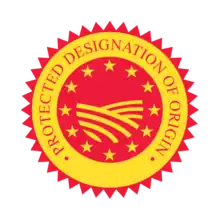Protected designation of origin
The protected designation of origin (PDO) is a type of geographical indication of the European Union and the United Kingdom aimed at preserving the designations of origin of food-related products. The designation was created in 1992 and its main purpose is to designate products that have been produced, processed and developed in a specific geographical area, using the recognized know-how of local producers and ingredients from the region concerned.[1]

The list below also shows other geographical indications.
Features
The characteristics of the products protected are essentially linked to their terroir. The European or UK PDO logo, of which the use is compulsory, documents this link.[2] European Regulation 510/2006 of 20 March 2006 acknowledges a priority to establish a community protection system that ensures equal conditions of competition between producers. This European Regulation is intended to guarantee the reputation of regional products, adapt existing national protections to make them comply with the requirements of the World Trade Organization, and inform consumers that products bearing the protected designation of origin logo comply with the conditions of production and origin specified by the designation. The Regulation applies to certain agricultural products and foods for which there is a link between the characteristics of the product or the food and its geographical origin: they may be wines, cheeses, hams, sausages, olives, beers, fruits, vegetables, breads or animal feed.[3][1][4]
Foods such as Parmigiano-Reggiano, Gorgonzola, Asiago cheese, Camembert de Normandie, and Champagne can be labeled as such only if they come from the designated region. For example, to be marketed under the Roquefort designation of origin,[5] a cheese must be processed from raw milk from a certain breed of sheep (Lacaune), the animals must be raised in a specific territory and the cheese obtained must be refined in one of the cellars at Roquefort-sur-Soulzon in the French department of Aveyron, where it must be seeded with mold spores (Penicillium roqueforti) prepared from traditional strains endemic to these same cellars.[2]
PDO in different languages
The PDO logo is available in all languages of the European Union and companies are free to use the logo and abbreviation of any of the versions. Examples of different language versions are shown below:
| Language | Name | Abbreviation |
|---|---|---|
| Bulgarian | Защитено наименование за произход | ЗНП |
| Croatian | Zaštićena oznaka izvornosti | ZOI |
| Czech | Chráněné označení původu | ChOP |
| Danish | Beskyttet oprindelsesbetegnelse | BOB |
| Dutch | Beschermde Oorsprongsbenaming | BOB |
| Estonian | Kaitstud päritolunimetus | KPN |
| English | Protected designation of origin | PDO |
| Finnish | Suojattu alkuperänimitys | SAN |
| French | Appellation d'origine protégée | AOP |
| German | geschützte Ursprungsbezeichnung | g. U. |
| Greek | προστατευόμενη ονομασία προέλευσης | ΠΟΠ |
| Hungarian | Oltalom alatt álló eredetmegjelölés | OEM |
| Irish | Bunús Ainmníochta Cosanta | BAC |
| Italian | Denominazione d'Origine Protetta | DOP |
| Latvian | Aizsargāts cilmes vietas nosaukums | ACVN |
| Lithuanian | Saugomos kilmės vietos nuorodos | SKVN |
| Maltese | Denominazzjoni ta’ Oriġini Protetta | DOP |
| Polish | chroniona nazwa pochodzenia | ChNP |
| Portuguese | Denominação de Origem Protegida | DOP |
| Romanian | Denumirea de origine protejată | DOP |
| Slovakian | Chránené označenie pôvodu | CHOP |
| Slovenian | Zaščitena označba porekla | ZOP |
| Spanish | Denominación de origen protegida | DOP |
| Swedish | Skyddad ursprungsbeteckning | SUB |
European register
The protected names are entered in the European "Register of Protected Designations of Origin and Protected Geographical Indications", or "EU Quality Register" for short, which is maintained by the European Commission's Directorate-General for Agriculture and Rural Development.[6] The applications, publications, registrations and any changes are recorded in the DOOR (Database of Origin and Registration) database and can be accessed online by anyone.[7]
Starting on 1 April 2019, the online database eAmbrosia was put into operation by the European Commission, which lists information about protected wines, spirits and food in the European Union and the previous three different databases: E-SPIRIT-DRINKS, DOOR and E -BACCHUS replaced on 31 December 2019.[8]
Lists of PDO products by country
See also
- Appellation d'origine contrôlée (France)
- Appellation d'origine protégée (Switzerland)
- Geographical indications and traditional specialities in the European Union
- List of geographical indications in India
- List of Italian products with protected designation of origin
- List of Portuguese food and drink products with protected status
- List of Republic of Ireland food and drink products with protected status
- List of United Kingdom food and drink products with protected status
- Protected Geographical Indications for Georgian products
References
- Commission européenne (28 March 2023). "Politique de l'UE en matière de qualité des produits agricoles".
- Barham, Elizabeth; Sylvander, Bertil, eds. (2011). Labels of Origin for Food: Local Development, Global Recognition. CABI. p. 17. ISBN 9781845933777.
- "REGOLAMENTO (CEE) N. 2081/1992 - regione.sicilia.it". Archived from the original on 2014-03-01. Retrieved 2021-06-05.
- Catanzaro, Felicetta; Licciardo, Francesco (5 July 2006). "La riforma del Regolamento (CEE) 2081/92 sulla protezione delle indicazioni geografiche e delle denominazioni di origine". agriregionieuropa.univpm.it (in Italian). associazione Alessandro Bartola. Retrieved 24 February 2022.
- Hughes, Tom; Hughes, Meredith Sayles (2005). Gastronomie!: Food Museums and Heritage Sites of France. Piermont, NH: Bunker Hill Publishing. p. 19. ISBN 1-59373-029-2.
- "La réforme des appellations en 2009". Archived from the original on 2014-10-05. Retrieved 2021-06-05.
- Source de la définition : Commission européenne (28 March 2023). "Politique de l'UE en matière de qualité des produits agricoles". European Commission (in French).
- "REGOLAMENTO (CE) N. 510/2006 DEL CONSIGLIO del 20 marzo 2006 relativo alla protezione delle indicazioni geografiche e delle denominazioni d'origine dei prodotti agricoli e alimentari". Archived from the original on 22 April 2013. Retrieved 7 June 2019.